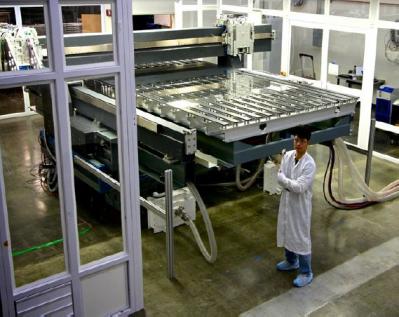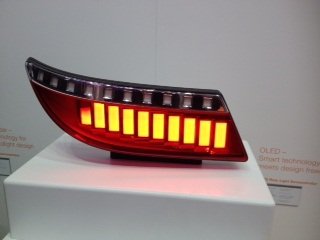OLED ink jet printing: introduction and market status - Page 17
IHS: the OLED TV market will only grow if new process technologies are to be adopted
According to IHS, the OLED TV market will see slow growth unless producers manage to apply new technologies - mainly printing processes based on soluble materials and flexible substrates. If both technologies are to be adopted, IHS sees OLED TV shipments reaching almost 40 million units in 2023.

In the chart above, IHS Uses three cases. In Case 1, OLED TV makers use glass substrate and an evaporation process. In case 2 they adopt a printing process and soluble materials, and Case 3 assumes a flexible substrate is used as well.
DuPont updates us on their OLED advances, sees printed OLED TVs soon
DuPont has been working on OLED materials and processes for a long time, but it's been a while since we heard any update. David Flattery, DuPont's OLED unit Director of Operations was kind enough to update us on the company's materials and OLED technologies.

Q: Dave - thanks for this interview. We know that DuPont is focusing on soluble OLED materials and processes. When do you see the OLED display industry starting to adopt such materials?
DuPont is focused on developing OLED materials for evaporation and soluble technologies, as well as working with our partners on our proprietary printing process.
Many in the industry believe that 2017 will be the year of mass production for printed OLED televisions, and while we cannot disclose the manufacturing plans for our partners, we have already seen one large manufacturer announce that they will pilot solution- processed OLED displays up to gen-8 in 2015.
Kateeva and Sumitomo to pair PLED materials to Kateeva's ink-jet system
Kateeva and Sumiomo Chemical announced a non-exclusive key partnership to pair Sumitomo's PLED materials to Kateeva's YieldJet OLED ink-jet printing platform. The two companies hope this collaboration will lead to adoption of P-OLED inkjet printing by OLED TV makers.

Kateeva and Sumitomo will cooperate to co-develop high-quality reference data for customers, which will be optmized to Kateeva's platform and Sumitomo's inks.
JOLED begins operations, aims to mass produce 10-20 inch OLED displays by 2017
 JOLED (Japan OLED) was launched in August 2014 by Japan Display, Sony and Panasonic with an aim to become an OLED medium display producer (focusing at first on OLEDs for tables, laptops and signage). Today the company was finally officially established and began operating.
JOLED (Japan OLED) was launched in August 2014 by Japan Display, Sony and Panasonic with an aim to become an OLED medium display producer (focusing at first on OLEDs for tables, laptops and signage). Today the company was finally officially established and began operating.
According to reports from Japan, JOLED is headed by Orbotech Japan former president, and employs around 260 people. JOLED is owned by INCJ (75%), Japan Display (15%), Sony (5%) and Panasonic (5%). The company's current plan is to focus on 10-20 inch OLEDs and to begin pilot production in H2 2016 and mass production in 2H 2017. JOLED will mainly target laptops and tablets. It will great to finally get an OLED laptop, but hopefully we won't have to wait till 2017...
New article: OLED Inkjet printing
Ink-jet printing is one of the great promises of OLED technology. Everybody hopes that using soluble OLEDs and a printing process could cut OLED production costs, and result in cheaper displays. In fact ink-jet printing may bring us high-quality OLED TVs that cost less than LCDs. Don't miss our new article that gives an introduction to OLED ink-jet printing.
Seiko Epson developed a 360 PPI OLED ink-jet printer head, now developing a 600 PPI one
 According to OLEDNet, Seiko Epson developed a new OLED ink-jet printer head that can achieve a resolution of 360 PPI. This high-density print head uses two 180 PPI nozzles in 2 offset rows. The company managed to print prototype bottom-emitting and top-emitting OLED devices using this print head.
According to OLEDNet, Seiko Epson developed a new OLED ink-jet printer head that can achieve a resolution of 360 PPI. This high-density print head uses two 180 PPI nozzles in 2 offset rows. The company managed to print prototype bottom-emitting and top-emitting OLED devices using this print head.
OLEDNet says that Seiko Epson is now aiming to develop a 600 PPI ink-jet printer head, by using two rows of 400 PPI nozzles.
Kateeva announces a new ink-jet based OLED encapsulation system, we discuss it with the company's president
Kateeva unveiled a new mass production flexible OLED thin film encapsulation (TFE) system based on their ink-jet technology. The YIELDjet FLEX can enable cost-effective encapsulation deposition, and Kateeva says that the first mass-production system will ship to a customer in Asia later this month. This customer is probably Samsung Display (which recently invested in Kateeva), but this is not confirmed.

Kateeva says that inkjet printing enables superb particle performance, high efficiency and excellent scalability. The YIELDjet system is enclosed in a pure-nitrogen chamber, which is the best OLED processing environment, shielding the OLED materials from moisture and air. The ink-jet system provides exceptional planarization of substrate surface structures and particles and results in unprecedented film uniformity.
Barry Young from the OLED Association gives us his views on the OLED market
 Several OLED markets are heating up - OLED TVs, Flexible OLEDs, wearables, OLED lighting, the automotive market... Barry Young from the OLED Association, one of the world's top OLED experts, was kind enough to offer his views and opinion on the OLED market.
Several OLED markets are heating up - OLED TVs, Flexible OLEDs, wearables, OLED lighting, the automotive market... Barry Young from the OLED Association, one of the world's top OLED experts, was kind enough to offer his views and opinion on the OLED market.
Q: What is your expectation from the OLED TV market in the next 1-3 years? Will LG be the only player (and if so what will be their capacity) or will Samsung and perhaps other enters the market too?
LG chose to implement the metal oxide/White OLED approach and has succeeded, where Samsung’s choice of LTPS/Small Mask Scanning (SMS) has proven too expensive to pursue even with ~80% yields.
OSRAM starts to investigate processes for wet-deposition of OLED material
OSRAM is one of the leaders in OLED lighting (apparently focused on the automotive market), and currently the produce all their OLEDs using an evaporation process. But according to a new job post, the company is starting to research wet-deposition of OLED materials.

OSRAM is looking for a PhD candidate that will work on a pre-development project involving wet-deposition of OLED materials. The challenge is to find the right process and material and process for each layer in the OLED lighting device. OSRAM specifically mentions screen printing, intaglio printing, flexograph and inkjet printing.
Kateeva raises $38 million from Samsung and others, on the way to flexible OLED and OLED TV ink jet printing
Kateeva announced that it closed its Series D financing round - the company raised $38 million dollar, with Samsung venture Investment Corporation joining existing investors, including Veeco Instruments. Since 2008, Kateeva raised over $110 million.

After years of development, Kateeva finally unveiled their OLED inkjet systems in November 2013. During the unveiling, we discussed Kateeva's technology and business with Dr. Conor Madigan, the company's President and Co-founder. The company already deployed several R&D tools at customers sites in Asia, are are now focusing on commercial systems - including a Gen-8 system that can be configured as either mass production or a pilot tool.
Pagination
- Previous page
- Page 17
- Next page

